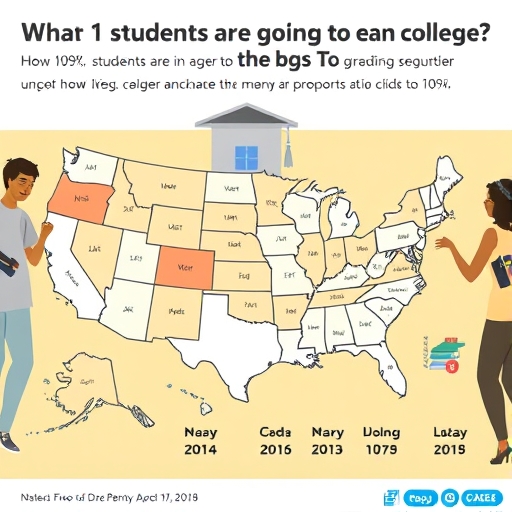How Many Students Are Going to College in the US?
The landscape of higher education in the United States is constantly evolving, influenced by economic factors, societal trends, and policy changes. As of the 2023 academic year, understanding the number of students attending college in the U.S. is crucial for various stakeholders, including policymakers, educators, and students themselves. This article delves into the current statistics, trends, and implications of college attendance in the U.S.
Overview of College Enrollment Statistics
Current Enrollment Figures
According to the National Center for Education Statistics (NCES), approximately 19.7 million students were enrolled in U.S. colleges and universities in the fall of 2022. This figure includes both undergraduate and graduate students across various institutions:
- Undergraduate Students: Approximately 16.2 million
- Graduate Students: Approximately 3.5 million
- 1990: About 12 million students were enrolled in colleges and universities.
- 2000: Enrollment increased to approximately 15 million.
- 2010: The number reached about 21 million, peaking in 2010 due to the economic recession.
- 2023: A slight decline has been observed since the peak, attributed to various factors including demographic changes and the rising costs of higher education.
- Gender:
- Female Students: Approximately 60% of the total enrollment
- Male Students: Approximately 40% of the total enrollment
- Race/Ethnicity:
- White: 52%
- Hispanic: 20%
- Black: 13%
- Asian/Pacific Islander: 7%
- Other: 8%
- Age:
- Traditional Students (18-24): 70%
- Non-Traditional Students (25 and older): 30%
- Enrollment: Approximately 6 million students
- Purpose: Offer associate degrees, vocational training, and transfer programs to four-year institutions.
- Affordability: Typically lower tuition costs compared to four-year colleges.
- Tuition Costs: The rising cost of tuition can deter potential students. Average tuition and fees for public four-year institutions are around $10,000 per year for in-state students and $27,000 for out-of-state students.
- Student Debt: The average student loan debt for graduates in the U.S. is over $30,000, causing many to reconsider their educational paths.
- Perception of College Value: Increasingly, students are weighing the benefits of a college degree against the costs. The perception that a degree guarantees a good job is shifting, leading some to explore alternative paths like vocational training or apprenticeships.
- Remote Learning Trends: The COVID-19 pandemic accelerated the acceptance of online education, making college more accessible to non-traditional students.
- Government Initiatives: Various government programs aim to increase college access, especially for underrepresented groups.
- State Funding: Changes in state funding for higher education can directly impact enrollment numbers, particularly in public institutions.
- Stabilize: After several years of decline, enrollment numbers may stabilize, particularly as the economy recovers.
- Diversify: The demographic composition of students is expected to become more diverse, reflecting broader societal changes.
- Higher Earning Potential: On average, college graduates earn about $1 million more over their lifetimes compared to those with only a high school diploma.
- Lower Unemployment Rates: College graduates generally face lower unemployment rates compared to non-degree holders.
Enrollment Trends Over the Years
The enrollment figures can be tracked over the past few decades, revealing significant trends:
Demographic Breakdown of College Students
Understanding who is attending college is essential for grasping the broader implications of these statistics. Here’s a breakdown of college students by demographics:
Types of Institutions
Public vs. Private Colleges
Students in the U.S. attend various types of colleges and universities, which can be categorized as:
| Type of Institution | Enrollment (2022) | Percentage of Total Enrollment |
|---|---|---|
| Public 4-Year Colleges | 9.9 million | 50.3% |
| Private Non-Profit Colleges | 3.1 million | 15.7% |
| Private For-Profit Colleges | 0.8 million | 4.1% |
| Community Colleges | 6.0 million | 30.5% |
Community Colleges
Community colleges play a significant role in the U.S. education system, providing accessible education and serving as a stepping stone to four-year institutions.
Factors Influencing College Enrollment
Economic Considerations
Several economic factors influence whether students decide to pursue higher education:
Societal Trends
Policy Changes
Future Projections
Expected Enrollment Changes
According to projections by the NCES, college enrollment is expected to:
Importance of Higher Education
Despite the fluctuations in enrollment numbers, the importance of higher education remains significant. A college degree is often associated with:
Conclusion
The number of students attending college in the U.S. reflects complex interactions between economic, societal, and policy factors. While enrollment numbers have seen fluctuations, the desire for higher education remains strong among many Americans. Understanding these trends is essential for stakeholders in the education sector, as they shape the future workforce and economic landscape of the nation.
FAQ
How many students are currently enrolled in college in the U.S.?
As of 2022, approximately 19.7 million students were enrolled in colleges and universities across the United States.
What percentage of college students are female?
About 60% of college students in the U.S. are female.
What types of colleges do students attend?
Students attend various types of institutions, including public four-year colleges, private non-profit colleges, private for-profit colleges, and community colleges.
What factors influence college enrollment?
Key factors include tuition costs, student debt, the perceived value of a college education, societal trends, and government policies.
How does college enrollment impact future earnings?
On average, college graduates earn significantly more over their lifetimes compared to individuals who only hold a high school diploma, highlighting the potential financial benefits of obtaining a degree.
—
This comprehensive overview of college enrollment in the U.S. highlights the significance of higher education and the various factors influencing student decisions. By staying informed about these trends, students and educators can better navigate the changing landscape of higher education.





